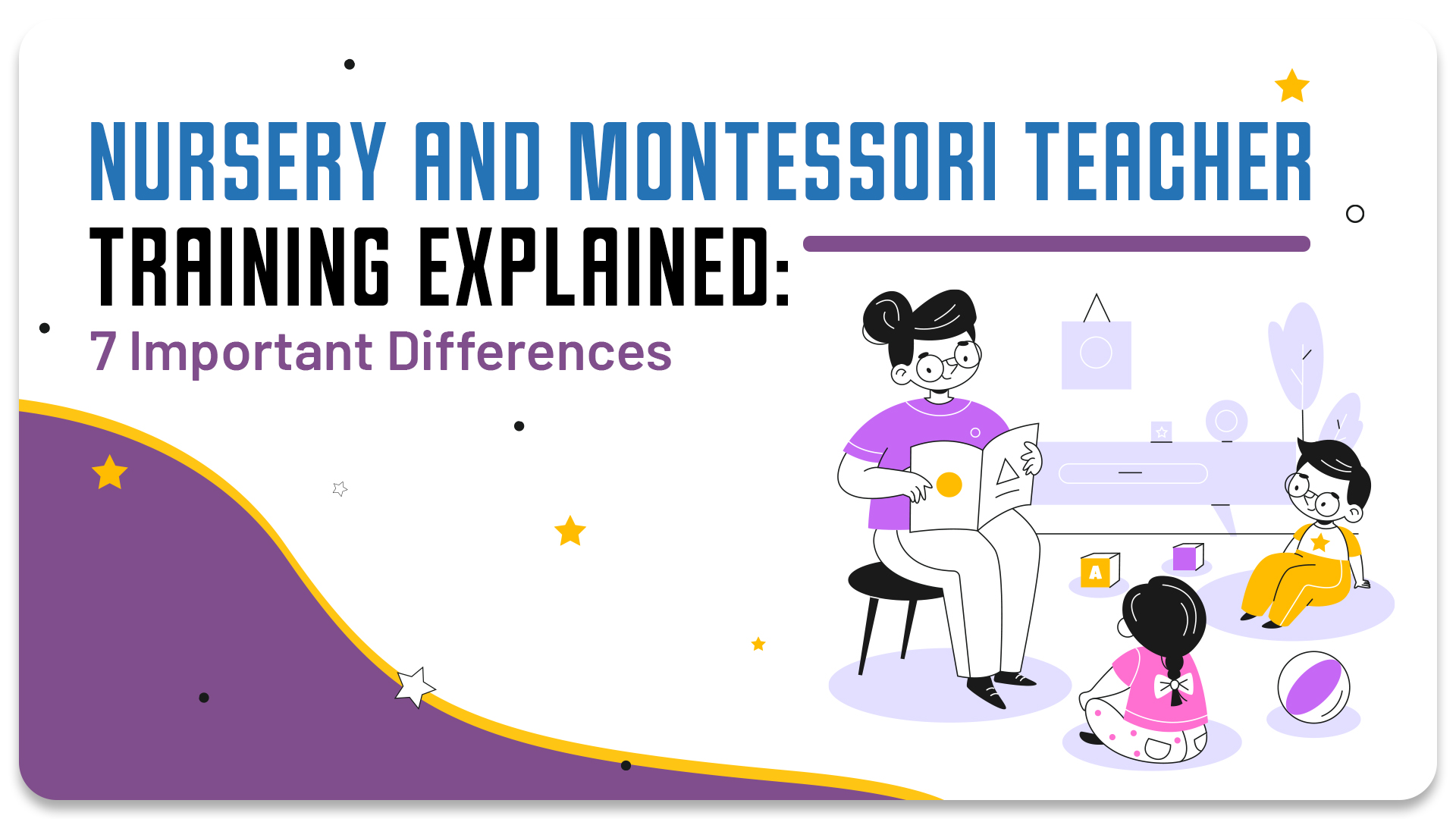Nursery and Montessori Teacher Training Explained: 7 Important Differences




_d6OPmqg%20(1).png)
Traditional Teacher Training focuses on teaching methods, subject knowledge, and classroom management techniques. Teachers are trained to deliver information to students in a structured, teacher-centered way.
Montessori Teacher Training emphasizes child-centered learning, observation skills, and the preparation of a carefully designed learning environment. Teachers are trained to guide children's learning through hands-on activities and individualized instruction.
This definition doesn't feed your curiosity, so let's look at the 7 major differences between traditional teaching and Montessori teaching. By the end, you'll have a better idea of which one is the best fit for you.
Traditional: In a traditional classroom, the teacher is the primary source of knowledge. They are the ones who explain concepts and provide information to the students. The teacher will give:
They usually lead the entire class, and students follow along, taking notes or answering questions based on the information provided.
Montessori: In a Montessori classroom, the teacher’s role is different!
Instead of just delivering information, the teacher is seen as a guide. The teacher observes the child’s actions and supports their exploration. The teacher may:
The goal is to nurture a child's curiosity and help them learn through hands-on experiences, at their own pace.
This approach promotes a deeper understanding because the child is actively involved in the learning process. It gives a strong foundation for making discoveries on their own with the teacher gently guiding them along the way.
In a traditional classroom, it is typically arranged with rows of desks facing the front of the room. The teacher is the primary source of knowledge, and the curriculum is often standardised.
A traditional classroom may include:
A Montessori classroom is a carefully prepared environment designed to stimulate children's natural curiosity and love of learning. It is filled with a variety of materials and activities that are organized into learning areas. It includes:
By doing so, the students are developing independence, concentration, self-discipline, and creativity.
In traditional classrooms, learning is mostly teacher-directed. The teacher decides what is taught, how it's taught, and when it's taught. Students are expected to listen, take notes, and memorize facts.
This can seem boring to kids, and they may show a lack of interest in learning.
On the other hand, in Montessori classrooms, learning is child-centred, meaning the focus is on the child's interests and natural curiosity.
Instead of just following instructions, children are encouraged to explore materials, ask questions, and solve problems on their own. This leads to active participation from the child in the learning process.
Look at the example first! Imagine student might take a maths test with a set of problems that test their understanding of concepts, such as addition, subtraction, or multiplication.
The student receiving a grade on the test reflects how well the student performed compared to a set standard. While this type of assessment is useful for quickly testing their memorization power and it can be limited too.
It tends to focus more on short-term memorization and this approach may also create stress and anxiety for students who struggle with test-taking when they are attending traditional assessment.
Instead of relying on tests and grades, In Montessori, teachers observe how children engage with materials, their problem-solving skills, and their growth in various areas.
The Montessori assessment method encourages a more holistic view of the child's learning and progress. It nurtures a child's love for learning by focusing on growth, effort, and development rather than just outcomes.
Individualized Learning: are expected to learn the same material at the same time and at the same pace.
In Montessori classrooms, learning is individualized. This means that each child is allowed to work at their own pace. If a child needs more time to understand a concept, they can take the time they need without feeling pressured.
This approach allows children to explore subjects they are passionate about, which can make learning more engaging and enjoyable. The individualized pace helps children feel more in control of their learning and supports their natural curiosity.
In traditional classrooms, discipline is often based on punishment and rewards. This means that students may face consequences like being sent to the principal's office, losing privileges, or receiving negative feedback when they misbehave.
In Montessori classrooms, discipline is based on positive guidance and conflict resolution. Instead of relying on punishments or rewards, teachers guide children toward understanding their behavior and its consequences. For example, if a child is arguing with a classmate over a toy, the teacher will help them talk through the problem and find a peaceful solution. The focus is on teaching children how to resolve conflicts calmly, express their feelings appropriately, and understand the importance of respect for others. This type of discipline encourages self-regulation, emotional intelligence, and responsibility.
Reward system inside a Montessori classroom
In traditional classrooms, community building may be less emphasized, with a focus primarily on individual achievement. Students are often encouraged to compete with each other to do well in exams, get the highest grades, or be the best in class.
In Montessori classrooms, community building is an essential part of the learning process. Montessori training focuses on creating a sense of unity among children and teachers through shared experiences and cooperation. Children are encouraged to work together, share materials, and help one another with tasks.
When students come to join a Montessori course in Kerala, they often ask about the difference between Montessori teaching and traditional teaching. We have analyzed the aspects of both approaches and how each handles the development of children. Indeed, Montessori teaching focuses on the holistic development of the child. Therefore, it is essential to choose a top-rated Montessori course. At Interval, we offer an updated syllabus along with two global certifications, including UK certification and CEED. These certifications will help you land a job anywhere. If you want to become a Montessori teacher, contact us today!